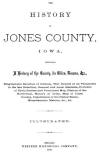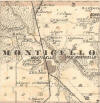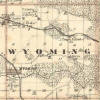 Û
History of Jones County, Iowa
Û
History of Jones County, Iowa
 Western
Historical Company, 1879.
Western
Historical Company, 1879.
The 1879 History of Jones County Iowa was transcribed by Janet A. Brandt
 To write the history of Anamosa and omit the name Edmund Booth,
would be to do injustice to a man of rare intelligence, extended
information, broad and liberal culture, with clear and concise opinions
on all important questions, and one whose long public life of industry
and usefulness has extended over the entire period from the time of the
early settlement of the county to the present moment, and one whose
voice, directly or indirectly, has been heard on almost every question
affecting the administration of the public affairs of the county, and
one whose unflinching integrity has secured for him the full and
complete confidence of all who know him, and which has made him an
oracle one very disputed point in the early history of the county. In
fine, to write the history of Jones County, particularly that portion
pertaining to Fairview Township, with the name Edmund Booth omitted,
would be as unsatisfactory as "the play of Hamlet with the Prince of
Denmark left out."
To write the history of Anamosa and omit the name Edmund Booth,
would be to do injustice to a man of rare intelligence, extended
information, broad and liberal culture, with clear and concise opinions
on all important questions, and one whose long public life of industry
and usefulness has extended over the entire period from the time of the
early settlement of the county to the present moment, and one whose
voice, directly or indirectly, has been heard on almost every question
affecting the administration of the public affairs of the county, and
one whose unflinching integrity has secured for him the full and
complete confidence of all who know him, and which has made him an
oracle one very disputed point in the early history of the county. In
fine, to write the history of Jones County, particularly that portion
pertaining to Fairview Township, with the name Edmund Booth omitted,
would be as unsatisfactory as "the play of Hamlet with the Prince of
Denmark left out."  The township, named after the home of
Jefferson, is one of the northern tier of townships of the county, east
of Castle Grove, the northwest township. The South Fork of the Maquoketa
River enters the township near the northwest corner, runs diagonally
across, and leaves the township some two miles north of the southeast
corner. The Kitty Creek, a stream of considerable importance, enters the
township from the south and unites with the Maquoketa near the city of
Monticello. By means of these two steams and others flowing into them,
the township is well watered, and water-power, for mill purposes,
furnished the inhabitants.
The township, named after the home of
Jefferson, is one of the northern tier of townships of the county, east
of Castle Grove, the northwest township. The South Fork of the Maquoketa
River enters the township near the northwest corner, runs diagonally
across, and leaves the township some two miles north of the southeast
corner. The Kitty Creek, a stream of considerable importance, enters the
township from the south and unites with the Maquoketa near the city of
Monticello. By means of these two steams and others flowing into them,
the township is well watered, and water-power, for mill purposes,
furnished the inhabitants. The following were among the early settlers outside the
city of Monticello, the metropolis of the township: David Ralston, John
Stevenson, F. M. Hicks, Z. Farwell, Robert A. Rynerson, A. H. Marvin, W.
H. Walworth, John Clark, Chauncey Mead, George George, William Clark,
Curtis Stone, John White, Asa C. Bowen and others.
The following were among the early settlers outside the
city of Monticello, the metropolis of the township: David Ralston, John
Stevenson, F. M. Hicks, Z. Farwell, Robert A. Rynerson, A. H. Marvin, W.
H. Walworth, John Clark, Chauncey Mead, George George, William Clark,
Curtis Stone, John White, Asa C. Bowen and others. This township is situated in the southeast
part of the county, north of Oxford, the southwest township. The most of
the surface is rather broken; there is a strip of prairie on the south
side, and some prairie land in the northwest corner, which is level or
beautifully undulating. A ridge, commonly known as the Brainard Ridge,
runs through about the center of the township from west to east, along
which there are fine farms and good substantial buildings. The northeast
corner is principally timber-land, with an occasional slope of prairie
interspersed among it.
This township is situated in the southeast
part of the county, north of Oxford, the southwest township. The most of
the surface is rather broken; there is a strip of prairie on the south
side, and some prairie land in the northwest corner, which is level or
beautifully undulating. A ridge, commonly known as the Brainard Ridge,
runs through about the center of the township from west to east, along
which there are fine farms and good substantial buildings. The northeast
corner is principally timber-land, with an occasional slope of prairie
interspersed among it.